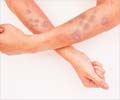Researchers have cited that an investigational antiviral drug may act as a potential treatment strategy to reduce muscle cell damage in Duchenne and other forms of muscular dystrophy (MD).
Researchers at Cincinnati Children’s Hospital Medical Centre have cited that an investigational antiviral drug may act as a potential treatment strategy to reduce muscle cell damage in Duchenne and other forms of muscular dystrophy (MD). The drug has been currently undergoing human trials in Europe for treating Hepatitis C infections.
The drug, namely Debio-025, is a popular inhibitor of the protein cyclophilin D, regulates the swelling of mitochondria in response to cellular injury.The study was led by Jeff Molkentin, Ph.D., a researcher in the Division of Molecular Cardiovascular Biology at Cincinnati Children’s.
In earlier laboratory tests, the researchers saw that when a gene encoding cycolphilin D is deleted, it reduced swelling and reversed or prevented the disease’s muscle-damaging characteristics. This led them to test the drug in mice engineered to carry MD. These mice were engineered as models of Duchenne muscular dystrophy and forms caused by a deficiency of two structural proteins, delta-sarcoglycan and laminin alpha2.
“Similar to deleting the gene encoding cyclophilin D, we found that treatment with Debio-025 reduced mitochondrial swelling and necrotic manifestations in mice with muscular dystrophy. This is why we believe inhibiting cyclophilin D could be a new treatment strategy. Debio-025 has already passed Phase II clinical trials in Europe and is considered safe in people, so we want to explore the possibility of conducting clinical trials in patients with Duchenne MD,” Nature Medicine quoted Molkentin, as saying.
It was found that when muscular dystrophy starts, the loss of certain proteins critical to muscle function, like dystrophin may cause contraction-related micro-tears in muscle fibres and an influx of calcium around muscle tissue.
At this time, cyclophilin D is initiated to render the membranes of mitochondria more permeable, which makes the mitochondria to be flooded by calcium and reorganize, swell and eventually rupture. This in turn leads to cell death in muscle fibers and also causes progressive muscle weakness, wasting and often early death associated with muscular dystrophy.
Advertisement
The researchers deleted the gene encoding cyclophilin D in these mice, and it was found that the muscle cells returned to near normal and did not exhibit substantial signs of swelling and cell death. Later, the experiment was repeated with mice lacking a gene encoding laminin alpha2, which causes a more severe dystrophy, swollen skeletal muscle cells and premature death before the mice reachin two months of age.
On of the common inhibitor of the protein is the drug cyclosporine; however its use is a little tricky as it also inhibits a protein, calcineurin, vital to skeletal muscle cell repair after injury and to skeletal muscle cell development.
Debio-025 has an upper hand in that it inhibits cyclophilin D and blocks cell death in a number of situations. It also does not curb the immune system or block calcineurin.
Muscular dystrophies are inherited disorders usually targeting striated muscle tissue and mostly occur in boys. It causes progressive muscle weakness, wasting and in many instances death. But no known cure for muscular dystrophy has yet been discovered.
The study is published online in the recent issue of the journal Nature Medicine.
Source-ANI
SRM/K











